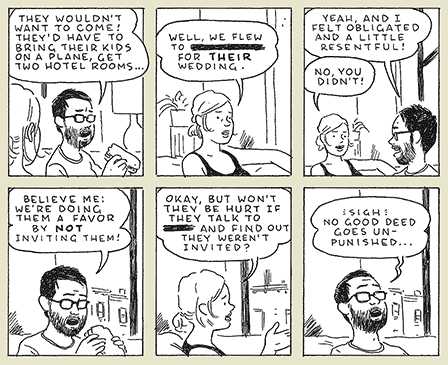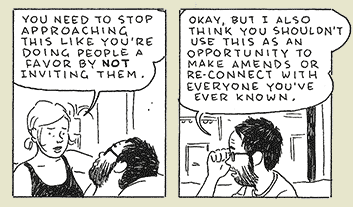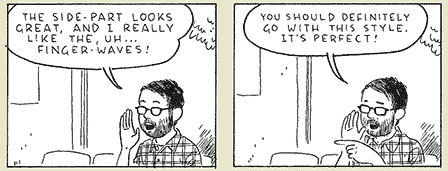Scenes from an Impending Marriage
When I was in the midst of my own ridiculously long engagement to Michelle, I was something of a stick in the mud. I complained about a lot of the irrational things that we were for some reason expected to do as part of the social ritual. Unity candle. Bouquet toss. White wedding dress. Bridesmaids and groomsmen. Inviting people. The usual.
I've never been big on traditions and have always done what I could to pare down the detritus that's accumulated over the decades and centuries on the shores of our celebrations. Like most people, I like the things I like and don't like the things I don't. Unlike some, however, I'm enough not a fan of tradition for tradition's sake that I bridle under its yoke. In short, tradition makes me grumpy.
In a lot of ways then, Adrian Tomine and I are pretty much the same person. I mean, I'm probably taller than him and am much more blonde. And have different personal ideologies and tastes and everything, sure. But in this one area, in answering the question of How to Throw a Wedding, we might be twins.

Scenes from an Impending Marriage, as every review will mention (because it's a neat detail!), was prepared by Tomine as a wedding favour for guests. This is hardly fair. We had handmade origami boxes filled with Starburst Jelly Beans at our wedding. Another guy I know had music boxes. Another friend made the mistake of doing goldfish (turned out a bit morbid for a celebration of love). Tomine's favors make ours look like we were not even trying and I'll forever loathe and love him for that. Still, having spent about a hundred hours designing our own wedding invitation (and another fifty building an artsy website), you probably couldn't have paid me to put together something that guests might have actually kept... Danggit.
*sigh*

Scenes is slight (at only fifty-six pages) and can easily be finished in under fifteen minutes. Tomine uses his page-space to chart the decision-making process of the newly engaged couple. As non-fiction, the book specifies Tomine and his fiancée's experience, but really Scenes plays pretty close to universal in the struggles it represents. Nearly all couples probably experience these same struggles as they work to plan a wedding, even if the details vary.
There is the question of the invitation list, whom to add and whom to cull—and you don't even know these people your parents want included. There is the struggle of finding a place for the reception that at all fits the couple's perception of what is acceptable, trying to balance taste, class, cost, style, and convenience, all while not lording their celebration over the less fortunate (a criterion which, to be fair, is probably not a bugbear glowering at too many engaged couples). Then there's homemade invites vs. those professionally prepared, live music vs. a DJ vs. an iPod, and hairstyles and florists and favours.
It's a pretty rapid fire tour of what awaits those who will soon be engaged, but for those who have been through it (or at least have good enough imaginations), Scenes rings true and the humourous look at wedding prep is a happy diversion.
 As always, it's all about the finger-waves.
As always, it's all about the finger-waves.
Still, Tomine's wedding favour threatens at becoming more than just a chronicle of engagement gags. It explores Interpersonal Interaction, that thing that makes relationships work or fall apart. We get insight into how at least one person views the dynamics of his particular experience of the boy-girl lego. And because of our sense of Tomine's honesty in his depiction, it comes off as probably being a fair indicator of how their relationship gears mesh. Scenes, then, is a historical document that chronicles not just the events as they have taken place, but of the interrelationship of the two human persons who are the central figures of these events.
And in comparison with other examples of intrusive entertainment that our voyeuristic culture produces, Scenes of an Impending Marriage is an actual joy to take in. (Only I'm not certain that it's ten dollars worth of joy.)
Good Ok Bad features reviews of comics, graphic novels, manga, et cetera using a rare and auspicious three-star rating system. Point systems are notoriously fiddly, so here it's been pared down to three simple possibilities:
3 Stars = Good
2 Stars = Ok
1 Star = Bad
I am Seth T. Hahne and these are my reviews.
Browse Reviews By
Other Features
- Best Books of the Year:
- Top 50 of 2024
- Top 50 of 2023
- Top 100 of 2020-22
- Top 75 of 2019
- Top 50 of 2018
- Top 75 of 2017
- Top 75 of 2016
- Top 75 of 2015
- Top 75 of 2014
- Top 35 of 2013
- Top 25 of 2012
- Top 10 of 2011
- Popular Sections:
- All-Time Top 500
- All the Boardgames I've Played
- All the Anime Series I've Seen
- All the Animated Films I've Seen
- Top 75 by Female Creators
- Kids Recommendations
- What I Read: A Reading Log
- Other Features:
- Bookclub Study Guides










